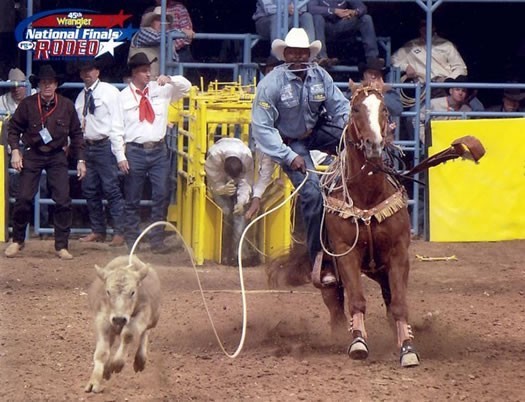“Just go ask him.”
The verbal nudge came from my father, and “him” was (at that point) six-time world champion calf roper Fred Whitfield, sitting astride a stout sorrel horse not 20 feet away. Whitfield had just finished sub-8-second run in Burley, Idaho, and was coolly watching as his remaining competitors plied their trade at the opposite of the arena. From my seat in Row 10, I could see that Whitfield had clenched his jaw and was staring lasers across the arena, obviously upset about the precious quarter-second a small stumble by his horse had cost him.
The rodeo at the Cassia County Fair has never been an A-list event, but they’ve always done a good enough job to lure a rodeo A-lister or two each year. By my teenage reckoning, Fred Whitfield was the crème de la crème. He was my rodeo hero, and he was just sitting there in front of me, if only I could muster the courage to ask for the legend’s autograph. With a final nudge from my dad and a deep breath, I picked my way down the crowded bleachers and stood at the fence.
“Hey, uh, Fred, could you sign my program?”
“Yeah, sure, kid.” Without a glance at me, he grabbed the Sharpie and program I offered him, quickly scribbled his name, then handed it back to me.
“Thanks!” I said, but Whitfield just kept his stern gaze pointed toward the roping chutes, 70 yards away.
As I climbed back up the bleachers, I couldn’t help but feel a little disappointed at being treated so dismissively by one of my heroes. But when I sat down and my little brother asked to see, I looked down at the page. There it was, splashed across a photo of himself: “Fred Whitfield, world champ 6×.” The disappointment melted away. It was, in a word, awesome.

Just last winter, I made the drive from my home in eastern Idaho south to Salt Lake. The occasion was to attend a Utah Jazz game with my dad and brothers. We’ve all been Jazz fans forever, and this was the first time we had all attended a game together. To sweeten the deal, the Jazz were playing the Dallas Mavericks, who happen to employ Dirk Nowitzki, easily my favorite non-Jazz player of all time. He’s spent the last two decades revolutionizing the game of basketball as a three-point-shooting seven-footer (though, to be fair, there’s much more to his game than that). At this point in his career, Dirk knees are creaky and it takes him about 20 minutes to make each trip up and down the court. Nonetheless, I was excited to see him in person. I of course was rooting for the Jazz to win, but I just had to see a Dirk three in person.
Early on, it was clear the Jazz would come away with a victory, so my rooting interests turned to Dirk’s distance shooting. Midway through the third quarter, it finally came. In semi-transition, trailing the play, Dirk received a pass at the top of the key and let fly. Swish. I, a reasonably rational grown man, went nuts.
Five minutes later, though, it was announced that the league officiating office had reviewed Dirk’s three-pointer and determined his toe was on the line, making it in actuality a regular old two-point shot. I don’t think he made another shot the rest of the game, and I walked out of the arena a tad deflated. Sure, I had gotten to see Dirk Nowitzki in person, but he hadn’t managed to do the one thing he was supposed to.
But, much like I had with Fred Whitfield years before, I ultimately came to appreciate that the shot had looked like a three from my seat, and that’s how it would remain in my memory.

As I take on the mantle of editor of Sugar Producer, I feel a little like the roles have reversed. For decades, this has been the preeminent publication of the U.S. sugarbeet industry, delivering some of the best and most relevant content to growers and others in the industry. I know when this magazine hits your mailbox, you expect a lot of it, thanks to the hard work of my predecessor, Allen Thayer, and editors before him.
For the past four years, I have served as the editor of Sugar Producer’s sister magazine, Potato Grower, and have always been impressed not only with the content, but with the unique way the sugar sector operates in respect to the greater agriculture industry. Hopefully my novice status in the sugar realm won’t impinge on your ability to gain the valuable knowledge you expect—and hopefully will continue to expect—from Sugar Producer. This magazine should never be a disappointment.